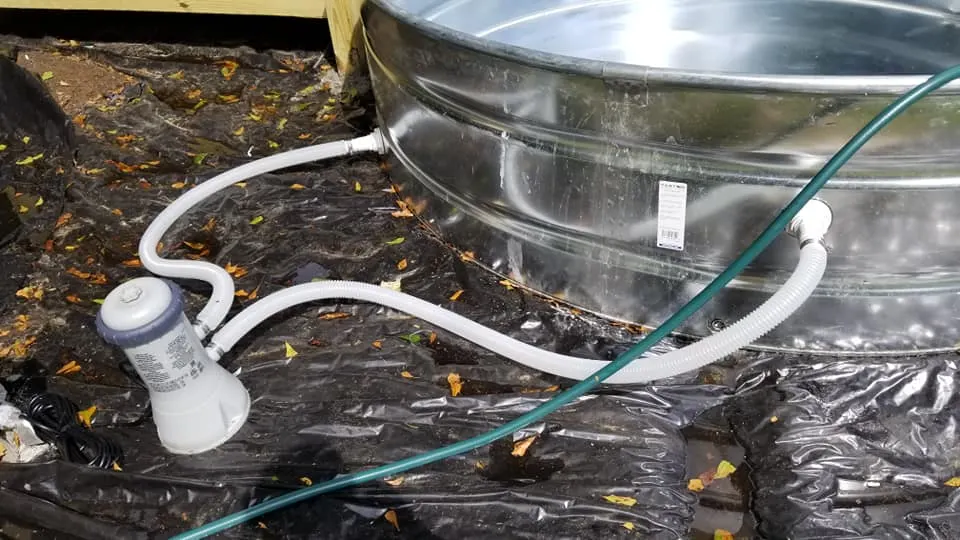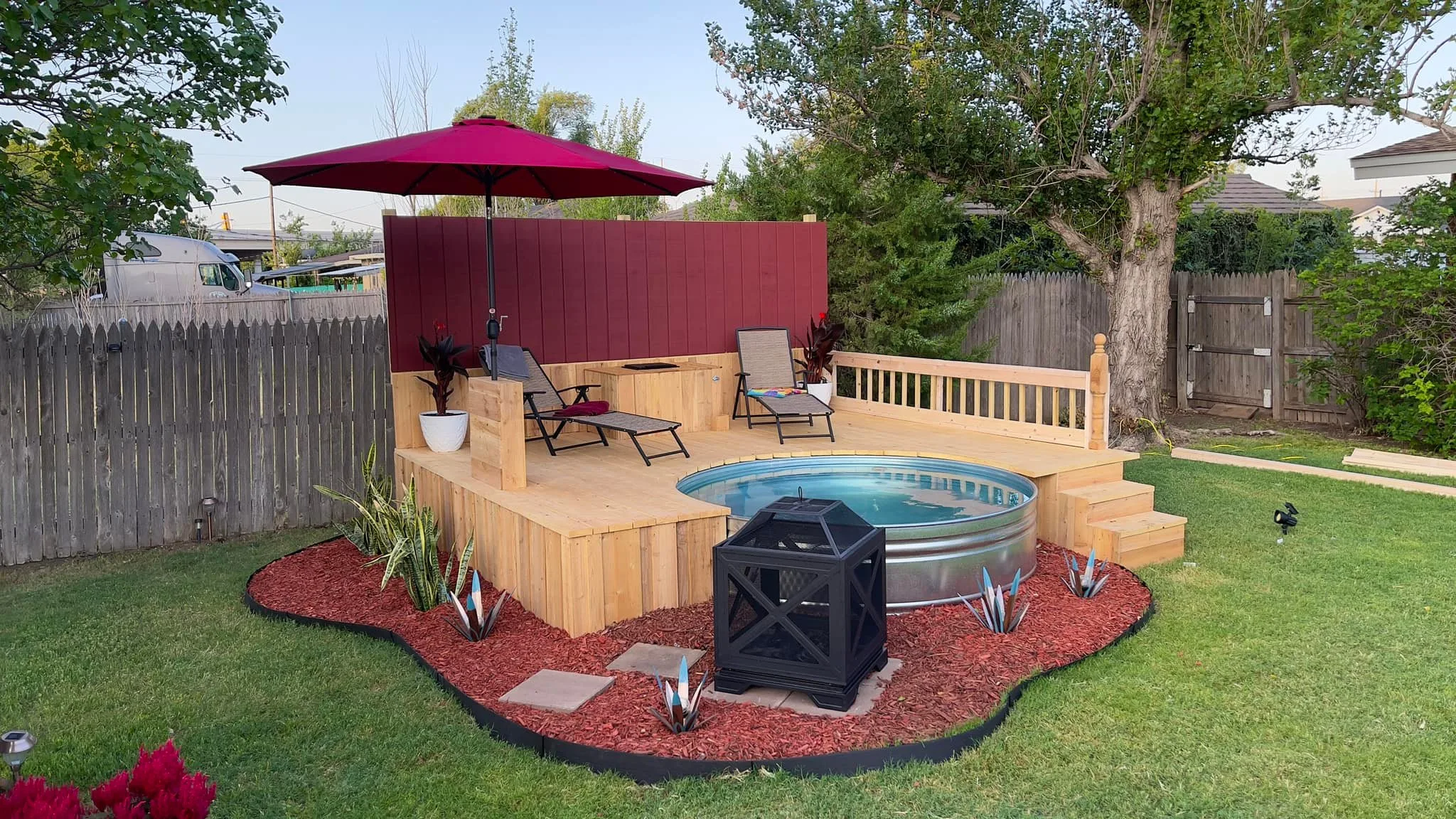Should you drain a stock tank pool? Clearly, the answer is yes. There are a few reasons you might need to drain your stock tank pool.
One reason is that the water may be too murky and cloudy for swimming. If swimming pools are left unmaintained, recreational water illnesses can also survive and grow in them. This causes the pool water to be uncomfortable, and even dangerous.
The most common pool-related illnesses include diarrhea caused by E. coli after swallowing even just a small amount of pool water, skin and eye irritation, as well as respiratory infections caused by inhaling aerosolized mists containing germs.
Finally, if you’re not going to use the stock tank pool for a while, it is a good idea to drain it so that the water does not get stagnant.
A stagnant pool can attract mosquitoes and will stimulate algae growth, making frequent pool draining and pool cleaning necessary to maintain the safety of your pool water.
Having said that, the following is a helpful guide on how to drain a stock tank pool.

Source: Matt N Michelle Baughcum (Georgia)
Page Contents
How to Drain a Stock Tank Pool?
A stock tank pool can be drained with the attached water pump connector, which includes the stock tank drain plug that makes it easy to remove the hose and let the water flow out.
Despite this, there is going to still be a few inches of water remaining in the pool after the plug is removed, so you will need other equipment to remove it.
You can use a portable water transfer pump, or a wet/dry vacuum if you want to get rid of any remaining water.
Using a Stock Tank Pool Plug
When installing your stock tank pool, some pool parts will be necessary to make your stock tank function properly as a pool, including a pool pump and a water heater if you wish to convert it to a hot tub during the winter months.
It is also necessary to install a stock tank drain plug, which consists of two rubber gaskets, and a new hard rubber outer ring.
You can also use a pre-wrapped threaded interior and exterior plug from your plumber. You can easily and safely drain the water with the plug.
However, this alone will not completely remove the water from the pool, leaving a few inches of water in the stock tank.

Source: Sheilah Dixon Huckabee (Georgia)
Using a Water Vac
The wet/dry vacuum is a convenient DIY solution to drain a stock tank pool completely.
Time savings and versatility are the biggest advantages of using wet/dry vacuum cleaners since you don’t have to vacuum and then mop the same area of floor twice. Tapping on the handle, you can easily switch between wet and dry vacuuming.
As such, a wet/dry vacuum can also be used to drain your stock tank pool. While it will take some time for the vacuum to completely extract all the remaining water, it is still a great and easy solution, even if you may have to repeatedly empty the vac’s contents.

Source: Sheilah Dixon Huckabee (Georgia)
Get a Transfer Water Pump
Even less supervision is required with a transfer water pump, which may require you to spend an additional $60.
Water is absorbed by an electric transfer water pump through a water suction attachment on the hose, allowing it to lie flat on the surface of your pool. With this, you can drain a stock tank pool in as quick as 20 minutes.
In general, a transfer water pump is used to move water from one place to another, but its functionality also proves useful to drain a stock tank pool, and even helps during storm cleanup, and leaking basements, among other things.
Make Use of Your Drained Stock Tank Pool
As the water is being drained, this is a good time to thoroughly clean your stock tank pool. Start by picking up visible debris such as leaves, twigs, and other particles.
You should then sweep and brush the side and the bottom of the stock tank in order to prevent algae growth and dirt buildup.
When refilling your stock tank pool with new water, check the water’s balance, as it may vary by location and should be tested with a water test kit.
Then, place your usual pool chlorine floater filled with a couple of chlorinated tablets to set in your pool water with chlorine. Be sure to remove it when people are swimming.
You might need to check out our detailed guide to caring for and maintaining a stock tank pool.

Source: Levi Oldham (Amarillo, Texas)
Final Thoughts
Draining a stock tank pool is more necessary than you might expect. Aside from replacing old pool water, this water may contain pool-related germs that may cause irritation or, worse yet, illness in the people swimming in it.
That being said, stock tank pools are relatively easy to maintain and install in your home, making them an ideal pool alternative for you to consider that you and your family will love.
Noah Edis is a passionate staff writer at Barndominium Life, a leading online resource for all things barndominium. With years of experience in the writing industry, Noah has made a name for himself as a skilled storyteller and a knowledgeable authority on the topic of barndominiums.
Noah’s interest in barndominiums began when he stumbled upon the concept while researching alternative housing options. Intrigued by the rustic charm and functionality of these converted barns, he soon became obsessed with the idea of living in one himself. He spent countless hours researching the construction, design, and decorating aspects of barndominiums, and soon became an expert on the topic.
As a staff writer at Barndominium Life, Noah enjoys sharing his knowledge and passion for these unique homes with others. He has written numerous articles covering a wide range of topics, from the history of barndominiums to the best ways to decorate them. Noah’s writing is informative, engaging, and always on-trend, making him a valuable asset to the Barndominium Life team.
Noah is a graduate of the University of British Columbia, where he earned a degree in English Language and Literature. When he’s not writing about barndominiums, he can be found exploring the great outdoors, trying new restaurants, or spending time with his family and friends. Noah is dedicated to his craft and is always striving to improve his writing skills and knowledge of the barndominium lifestyle.
Connect with Noah on LinkedIn
